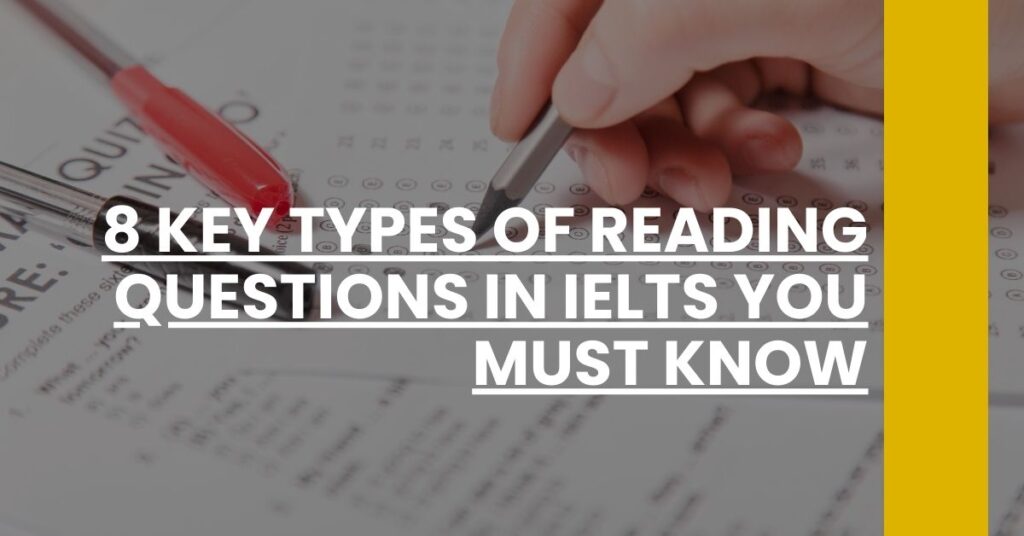Ever hit a wall when preparing for IELTS Reading due to the sheer variety of question types? You’re not alone.
Grasping the types of reading questions in IELTS can be your ladder to achieving that coveted band score.
This article distills the essence of each question type, offering targeted strategies that sidestep common pitfalls to elevate your reading comprehension prowess.
- 1. Matching Heading Questions
- 2. True, False, Not Given Questions
- 3. Multiple Choice Questions
- 4. Summary, Note, Table, Flow-Chart Completion Questions
- 5. Sentence Completion Questions
- 6. Short-Answer Questions
- 7. Matching Paragraph Information Questions
- 8. Choosing a Title Questions
- Effective Reading Strategies for IELTS
- Time Management During Reading Section
- Practice Makes Perfect
- Conclusion
1. Matching Heading Questions
When tackling the IELTS reading section, grasping the types of reading questions in IELTS is as crucial as the air you breathe. First up are Matching Heading Questions, a challenge that requires laser-focused skimming skills to align paragraphs or sections with their appropriate headings. Your mission is to dig out the core idea of each text fragment and hook it onto the right conceptual peg.
- Understand Each Heading: Before diving into the text, familiarize yourself with the list of potential headings. Think of each as a unique character with its own set of traits.
- Skim for Main Ideas: Your job isn’t to absorb every word but to capture the essence of each paragraph. Look for buzzwords or ‘theme’ words that reveal the main argument or narrative thread.
- Don’t Overthink: If you find yourself circling a headline like a moth to a flame, move on. It’s a race against the clock, and every second counts.
Refine your strategy by exploring different approaches and honing your innate ability to match information swiftly. Remember to practice regularly, as these questions are found on both the IELTS Academic and General Training Tests.
2. True, False, Not Given Questions
Here’s where your detective skills come to play. True, False, Not Given questions are the enigmatic trio in the types of reading questions in IELTS. You’ll dissect text to determine if statements are factual, incorrect, or not mentioned at all – a subtle but mighty distinction.
- Identify Facts vs. Opinions: It’s imperative to differentiate what the text asserts factually from what the writer may believe.
- Avoid Assumptions: Jumping to conclusions is a no-no. Base your judgment solely on the given evidence – assumptions can lead you astray.
- Answers Come In Order: Thankfully, the answers will follow the sequence of the text, sparing you from a wild goose chase.
Sharpen this precision-based skill with a series of targeted techniques and resist the temptation to let personal knowledge interfere with your answers.
3. Multiple Choice Questions
Welcome to the realm where your analysis of detail and nuance must seamlessly intertwine. Multiple Choice Questions demand that you not only comprehend the nuances within the text but also choose the one correct answer among several plausible ones – testing your ability to scan efficiently and think critically.
- Predict Before You Peek: Try to anticipate the answer before you get lured by the attractive yet potentially misleading options.
- Eliminate the Imposters: Cast aside options that don’t snugly fit the evidence in the text, and remember, the truth is often hidden in plain sight within the nuances of the passage.
- Double-Check: Even if an option seems to fit, validate it against the text – confirmation is the key.
Polish your expertise by throwing yourself into the action, practicing with real-life texts, and dissecting your decision-making process.
4. Summary, Note, Table, Flow-Chart Completion Questions
Embark on this journey where you’ll fill the blanks in summaries, notes, tables, and flow-charts. Here, attention to detail and context grasp is of utmost importance. It’s about understanding the undercurrents of the text and determining the specific piece of information that snugly occupies the vacant space.
- Scan for Synonyms: Keep an eye out for synonyms and paraphrases. The answer rarely comes wearing the same lexical outfit as the question.
- Predict the Gap: Anticipate the type of word or phrase that belongs in the blank. Is it a noun, a verb, or perhaps an adjective?
By implementing these strategies, not only do you enhance your linguistic agility but also your skill in zeroing in on that missing puzzle piece that completes the picture.
5. Sentence Completion Questions
Refine your type of reading questions in IELTS repertoire further with Sentence Completion Questions. Fasten your seatbelt as you navigate through complex texts to find the exact words or numbers that will perfectly fit into the given sentences. Clarity, precision, and a meticulous eye are your best friends here.
- Paraphrasing is Paramount: Keep in mind that the IELTS enjoys testing your ability to recognize ideas expressed in different ways. Warm up by practicing your paraphrasing skills.
- Mind the Word Limit: If the instruction dictates a two-word limit, respect it religiously – breaching it invites marks to vaporize.
Attain mastery in this area to seal those gaps with supreme confidence and a dash of panache.
6. Short-Answer Questions
Short-Answer Questions are the straight shooters of the IELTS reading arsenal. They require you to scour the text and extract precise nuggets of information, all without the comforting presence of multiple-choice scaffolding. It’s an exercise in surgical accuracy – find the data and deliver it with brevity.
- Skim with a Purpose: Pre-read the questions to tune your brain to the frequency of the answers. Engage in skimming to glimpse the general meaning.
- Underline Keywords: Armed with a mental highlighter, make keywords stick out as beacons guiding you to the correct response.
Developing prowess in delivering concise answers that hit the bullseye is an asset that pays dividends across the IELTS reading test spectrum.
7. Matching Paragraph Information Questions
The task here is akin to a matching game where you align specific information with the correct paragraphs. The IELTS reading section can feel like a labyrinth, but with the right strategies, it becomes a walk in the park.
- Read Each Statement: Begin by carefully reading each statement you’ve been given. It’s like getting the clues before you embark on your treasure hunt.
- Skim for the Core Idea: You’re not here to soak in every word but rather to fish out key information, similar to identifying landmarks while navigating a new city.
- Use Process of Elimination: If a paragraph doesn’t seem to fit, strike it off your list. It’s as efficient as clearing disarray to find a lost item.
Remember, it’s about finding the domain where the answer resides, skim to that neighborhood, and then scan for the house where your answer lives.
8. Choosing a Title Questions
A lesser-known type among the types of reading questions in IELTS is choosing a title for the whole passage. This demands a top-down approach; you need to get a firm handle on the passage’s overall theme.
- Look for an All-encompassing Option: This isn’t about details—it’s about the big picture. Pick a title broad enough to cover the entire scope of the passage.
- Avoid Narrow Choices: Titles that focus on just one aspect of the text are like a zoom lens—they miss the full panorama.
Permeate the text to snag the crux of the passage, and let that guide your choice.
Effective Reading Strategies for IELTS
Developing effective reading strategies is critical to conquering the diverse types of reading questions in IELTS.
Skimming and Scanning
Skimming allows you to swiftly grasp the gist, while scanning lets you pinpoint specifics.
Strong Vocabulary
A robust vocabulary equips you to navigate around paraphrases and synonyms.
Practice Regularly
The more diverse your practice materials, the better prepared you’ll be for the variety of passages on the test.
By committing to these reading strategies, you strengthen your foundational skills, making the actual questions feel less like obstacles and more like familiar stepping stones.
Time Management During Reading Section
Taming the clock is just as important as mastering the types of reading questions in IELTS.
- Allocate Wisely: Gauge the time you spend on each set of questions. Overindulgence on one can starve the others.
- Practice Skimming: Learn to skim efficiently, so you’re moving through the text with both speed and comprehension.
Remember, your minutes are currency—spend them judiciously.
Practice Makes Perfect
It’s an age-old adage for a reason—practice is the lifeline of IELTS preparation.
- Simulate the Real Test: Nothing beats the effect of sitting through full-length, timed practice sessions.
- Analyse Your Performance: Understand where you falter and adapt accordingly. It’s like recalibrating your compass mid-journey.
Gather an arsenal of practice material and make each session count—it’s the surest way to transform your approach from unsure to unbeatable.
Conclusion
Understanding the types of reading questions in IELTS is pivotal to your success. Embrace these strategies, apply them with diligence, and practice them till they become second nature. May every answer you seek surface with clarity, and every question be an opportunity to showcase your mastery. Keep going, because every piece of practice adds up to a performance that can surpass expectations—yours and the test’s.
Explore types of reading questions in IELTS and prepare effectively with our comprehensive guide on strategies and tips.

